#chronicle security operations
Text
Google expands partnership with Anthropic to enhance AI safety
New Post has been published on https://thedigitalinsider.com/google-expands-partnership-with-anthropic-to-enhance-ai-safety/
Google expands partnership with Anthropic to enhance AI safety
.pp-multiple-authors-boxes-wrapper display:none; img width:100%;
Google has announced the expansion of its partnership with Anthropic to work towards achieving the highest standards of AI safety.
The collaboration between Google and Anthropic dates back to the founding of Anthropic in 2021. The two companies have closely collaborated, with Anthropic building one of the largest Google Kubernetes Engine (GKE) clusters in the industry.
“Our longstanding partnership with Google is founded on a shared commitment to develop AI responsibly and deploy it in a way that benefits society,” said Dario Amodei, co-founder and CEO of Anthropic.
“We look forward to our continued collaboration as we work to make steerable, reliable and interpretable AI systems available to more businesses around the world.”
Anthropic utilises Google’s AlloyDB, a fully managed PostgreSQL-compatible database, for handling transactional data with high performance and reliability. Additionally, Google’s BigQuery data warehouse is employed to analyse vast datasets, extracting valuable insights for Anthropic’s operations.
As part of the expanded partnership, Anthropic will leverage Google’s latest generation Cloud TPU v5e chips for AI inference. Anthropic will use the chips to efficiently scale its powerful Claude large language model, which ranks only behind GPT-4 in many benchmarks.
The announcement comes on the heels of both companies participating in the inaugural AI Safety Summit (AISS) at Bletchley Park, hosted by the UK government. The summit brought together government officials, technology leaders, and experts to address concerns around frontier AI.
Google and Anthropic are also engaged in collaborative efforts with the Frontier Model Forum and MLCommons, contributing to the development of robust measures for AI safety.
To enhance security for organisations deploying Anthropic’s models on Google Cloud, Anthropic is now utilising Google Cloud’s security services. This includes Chronicle Security Operations, Secure Enterprise Browsing, and Security Command Center, providing visibility, threat detection, and access control.
“Anthropic and Google Cloud share the same values when it comes to developing AI–it needs to be done in both a bold and responsible way,” commented Thomas Kurian, CEO of Google Cloud.
“This expanded partnership with Anthropic – built on years of working together – will bring AI to more people safely and securely, and provides another example of how the most innovative and fastest growing AI startups are building on Google Cloud.”
Google and Anthropic’s expanded partnership promises to be a critical step in advancing AI safety standards and fostering responsible development.
(Photo by charlesdeluvio on Unsplash)
See also: Amazon is building a LLM to rival OpenAI and Google
Want to learn more about AI and big data from industry leaders? Check out AI & Big Data Expo taking place in Amsterdam, California, and London. The comprehensive event is co-located with Digital Transformation Week.
Explore other upcoming enterprise technology events and webinars powered by TechForge here.
Tags: ai, ai inference, anthropic, artificial intelligence, development, ethics, Google, google cloud, inference, large language model, llm, safety, Society, tpu v5e
#2023#ai#ai & big data expo#ai inference#ai news#ai safety summit#Amazon#amp#anthropic#artificial#Artificial Intelligence#benchmarks#Big Data#bigquery#Building#CEO#chips#Chronicle#chronicle security operations#Cloud#clusters#coffee#Collaboration#collaborative#command#Companies#comprehensive#data#data warehouse#Database
0 notes
Text
Safe Arms
Poly! Billy Loomis & Stu Macher x FTMale Reader
Fandom -> Scream 1996
Requested by -> Anon
Masterlist
Warning: Mention of Breasts


Woodsboro had quite the big population. Not as large as Los Angeles or Santa Monica of course, but enough not to feel completely out of place or knowing you would be one of the few—like how it would be most of the times in towns and Villages.
And yet, besides knowing you're not the only Trans-Person in Woodsboro, you do feel out of place—like a fish on land.
Maybe it was because throughout your school years and the slow progress of transition, you hadn't anyone to talk about it—to relate with someone who was like you and perhaps that was the reason why you felt like this, as if you didn't belong here or anywhere.
Though yet again, when you're with Billy and Stu—your boyfriends—you felt just right in where you are—because neither Billy or Stu, they knew about you being Trans since the beginning of your relationship, treat you any differently and saw you as what you truly are. A man.
It were moments like these, which proved your inner nagging thoughts into a silence, that you belonged here—be it Woodsboro or any other place you decided to live—and that you're not alone. Moments like these, which made you fall in love with your two mans over again.
It had been some stressful weeks for you, exams and part-time Job piling up onto your nerves—straining them to an snapping point—and when a wave of dysphoria had rolled over you—taunting your mind and self-confidence, which you build up slowly but steady over the years—to feel comfortable—your high strung nerves had snapped in half and you cried, more ugly sobbing it was, for two days.
You had stayed home the whole week—had forced yourself to go to school last week already, till it became unbearable much to even consider leaving your bed at all, without feeling so disoriented.
When Billy and Stu didn't saw you in school, they grew a bit worried about you—especially when you ignored their calls—having a good hunch of why you stayed at home—and once they've asked your older siblings and they confirmed their suspicions, Billy and Stu decided to visit you and do a sleepover.
~~~
Sitting in the middle of your bed, in nothing clad but boxers, you let Billy take off your binder—he's careful not touch whats beneath it—although you being on transition, the much needed operation to remove your breasts would only become real, when you had saved up enough money for it—and once the soft material was off from your skin, you wanted to curl into yourself and hide away.
The feeling of your breast—these ugly breasts, those lumps of flesh—which are now hanging freely on your chest, racked a shudder through your body—visible flinching away from Billy's hands and crossing your arms over your breasts—wanting to hide them, to make them disappear once more.
Billy pry'ed your arms from your chest, pulling one of Stu's shirts—which in terms of size—even though Stu's more lanky limps than bulky wide, he still wears shirts in size of XL or XXL—looks so massive on you, that it looks like as if you're swallowed whole in the material—over you.
You sighed out in relief, closing your eyes, when your breast were now covered—feeling more secure and comfortable again.
Stu, after setting up the dvd-player for tonight's movie marathon—which, despite being summer, consisted of the whole Halloween Chronicles and other Horror and Slasher movies—had crawled onto the bed as well—engulfing you in his long lanky but strong arms and covers your face with little smooches of butterflies kisses.
»You looks so sexy in my shirt, [Name], I could eat you up right away« Stu grinned, licking over his lips—thought about to lock you into a tongue battling french-kiss, but with your current mood it wouldn't be such a good idea to do so, didn't want to make you uncomfortable and cry—when you're already feeling so in the down—so instead Stu decides to give you a big final kiss on the cheek.
»Horrorfilms again?« you asked, cuddling more into Stu's side, when he had pulled you down to the mattress.
You had nothing against Horrorfilms, just to watch them 24/7 a week and throughout the year, could be a bit—a tiny bit—tedious to do so for your eyes and mind.
»What can I say, they are the best to watch. Aren't they? But don't worry, pretty boy, we will watch your favourite movies too.«
Billy calling you „pretty boy“ makes your heart soar—brought a small smile onto your lips—because that's what you are; a boy.
»Yeah, I am a pretty boy.« you repeated, voice still in a hushed whisper, but with confidence in it.
Billy placed the bags of chips around you all, getting into bed himself—pressing the button of the remote to start the first movie—and laying down next to you, draping an arm around your shoulders.
»Don't be a such a hogger, Stuie. I want a share of our darling boy too.«
»You're more a hogger than I am!« Stu furrowed his eyebrows slightly, pouting childish at Billy.
»Such a lie. You definitely hog him more.«
»Boys, I'm in the middle and you both get a fair share. So now, no more fighting and let's watch these movies now.« you said, patting each of their legs—knowing well that once a discussion between your boyfriends would break out, it could last the whole night and probably would go into the nasty side of insults.
Although you had a shitty week and still feeling in the dumpster—as if you didn't belong anywhere anymore at all—having Billy and Stu next to you, their arms around you, felt like the safest place on earth.
#male reader#x male reader#fanfiction#malereader#oneshot#xmalereader#billy loomis#scream x male reader#scream 1996#scream#poly! billy loomis & stu macher x male reader#stu macher#billy x stu x male reader#poly! billy and stu x male reader#billy loomis x male reader#stu macher x male reader#billy and stu x male reader#Billy Loomis and Stu Macher x Male Reader#ftm reader#x ftm reader#poly! ghostface x male reader#ghostface x male reader#ghostface
154 notes
·
View notes
Text

Archaeologists Uncover 'Prison Bakery' in Pompeii
An ancient bakery operated by slaves has been discovered in the ruins of Pompeii, the Pompeii Archaeological Park said in a statement released Friday.
Enslaved people and donkeys were locked up together and used to power a mill to grind grain for bread, according to details of the discovery provided by the park.
The site consists of a narrow room with no external view but only small, high windows covered by bars through which minimal light passed. There were also indentations in the floor “to coordinate the movement of the animals, forced to walk around for hours, blindfolded,” the statement said.
The discovery was made in the Regio IX section of the popular tourist site, which is also an ongoing archaeological dig. The area is currently being excavated as part of a larger project designed to secure and maintain previously excavated areas of the Roman city.

Archaeologists discovered the bakery while excavating an ancient Pompeiian home that was being renovated when Mount Vesuvius erupted in 79 C.E., covering the city of Pompeii with ash.
The bodies of three victims of the eruption were found in recent months, believed to be residents of the home rather than slaves. The house was divided into a residential section with “refined frescoes” on one side, and a commercial bakery on the other.
Next to the bakery was the dimly lit prison area, Pompeii Archaeological Park director Gabriel Zuchtriegel said in an interview posted on the site’s YouTube channel.

“What has emerged is testimony of the backbreaking work to which men, women, and animals were subjected in the ancient mill-bakeries,” he added.
Zuchtriegel said these prison bakeries were previously described by the Roman writer Apuleius in the 2nd century C.E., in his novel “Metamorphoses” (also known as “The Golden Ass”), in which the protagonist, Lucius, “transformed into a donkey and was sold to a miller.” Zuchtriegel said the episode was based on the writer’s direct knowledge of the animals and humans living and working together.

The newly discovered prison area had no doors to the outside, only to the inner atrium.
“It is, in other words, a space in which we must imagine the presence of people of servile status whose owner felt the need to limit the freedom of movement,” Zuchtriegel said.
“It is the most shocking side of ancient slavery, the side devoid of relationships of trust, where it was reduced to brute violence, an impression which is fully confirmed by the closing of the few windows with iron grates.”
Archaeologists also believe that the indentations in the slab flooring were not made by repetitive movement but were carved to prevent the donkeys and other animals from slipping on the pavement and to force them to only walk in a circular motion to grind the grain, almost like a clockwork mechanism.

“The iconographic and literary sources, in particular the reliefs from the tomb of Eurysaces in Rome, suggest that a millstone was normally moved by a couple made up of a donkey and a slave,” Zuchtriegel said.
“The latter, in addition to pushing the grindstone, had the task of encouraging the animal and monitoring the grinding process, adding grain and removing flour.”
The site will complement an exhibition that opens December 15, called “The Other Pompeii: common lives in the shadow of Vesuvius,” which is dedicated to what Zuchtriegel calls the “myriad of individuals often forgotten by historical chronicles, such as the slaves, who constituted the majority of the population and whose work contributed significantly to the economy, but also to the culture and social fabric of Roman civilization.”
By Barbie Latza Nadeau.
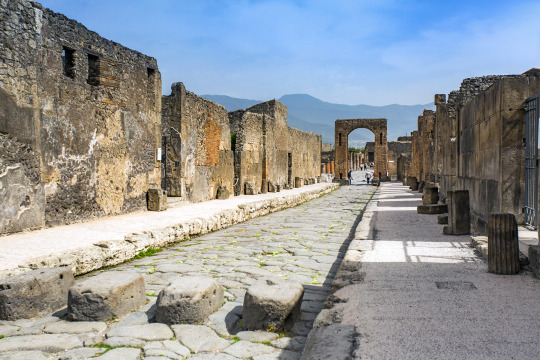
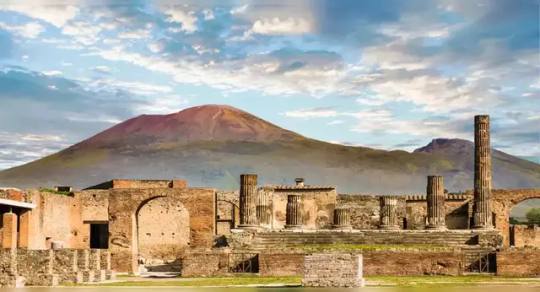
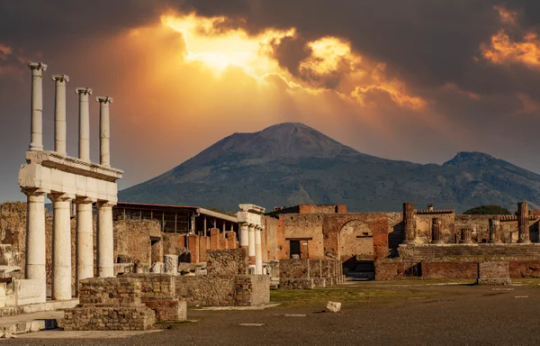
#pompeii#Archaeologists Uncover 'Prison Bakery' in Pompeii#ancient artifacts#archeology#archeolgst#history#history news#ancient history#ancient culture#ancient civilizations#roman history#roman empire#mount vesuvius
80 notes
·
View notes
Text
State of Terror: Life After Venezuela’s Electoral Uprising
In a voice message to the ruling party leadership, Maduro summoned PSUV militants and his remaining supporters to defend his rule: “Coordinate with National Police (PNB) and Guard (GNB) to restore order,” he commanded. “We have to grab this by the head. Act immediately. Every little fire that starts must be extinguished.”
On the morning of July 29th, while the Comando por Venezuela celebrated a de facto triumph of more than 30 points over Maduro—after processing 73% of the voting tallies—demonstrators returned home under the watchful eyes and cannons of colectivos and security forces.
On July 28, Venezuela’s government—perhaps dazzled by its own misreading of the situation—became exposed to electoral reality. The barrio, emerging as a new agent of change, slapped chavismo in the face, forcing it to embrace the only version of sovereignty Maduro understands: the power to dictate who lives, who dies, and who goes to jail, echoing the words of Cameroonian social theorist Achille Mbembe.
In a context where hundreds of thousands of people volunteered to defeat Maduro at the polls and then protect the evidence of their collective will, the brute force unleashed since July 29 seeks to destroy the spirit and hunger for change that Machado’s campaign activated.
As Chávez statues were toppled and Maduro posters torn down, the government, from its trenches in Miraflores and Fuerte Tiuna, tried to convince international mediators that Amoroso’s announced result wasn’t up for discussion. At the same time, it turned on all engines of its war machine, including an overblown rhetoric that doesn’t even pretend to be logical. Maduro, Diosdado Cabello, and Jorge Rodríguez have labeled those who oppose them—from local politicians to foreign governments, even on the left—as Nazis or fascists, describing demonstrators as drugged criminals from the U.S. and cells from the international criminal organization Tren de Aragua.
A week after the election, human rights NGO Foro Penal confirmed 1,102 arrests, with 170 of them in Caracas. Monitor de Víctimas reported 23 murders so far, with colectivos responsible for at least 9, operating in total sync with State security officers.
Like paramilitary forces fighting a hybrid war, colectivos work as PSUV’s fist in the areas where the chavista State holds more economic and social power over a population now turning its back on them. Their priority is to defend their government sponsors at gunpoint.
The offensive reached the doors of those who took to the streets the Monday after the presidential election. A video from that day shows a man on a bike recording himself while chasing demonstrators, saying to the camera: “Here we are, prepared to defend peace and our principles. We want peace, but we are prepared for war. In Venezuela, it was our president Nicolás Maduro who won. Guarimberos (a slur for protesters) ran to hide in their homes. From now on, we take over the streets that have always belonged to us, not to oligarchs!”
Communal councils and what’s left of the Hugo Chávez Battle Units—PSUV grassroots structures forming a sort of parallel chavista State—have been ordered to identify, locate, and point out anyone who called out the election fraud in different communities.
Under this war logic, anyone who poses a threat to those in power becomes a target for colectivos and security forces: demonstrators hiding in safe houses, people who showed their voting tallies or denounced the fraud on social media, and community leaders and members of comanditos who promoted participation and defended votes for Edmundo González.
On Tuesday the 30th, in the densely populated (and formerly very chavista) 23 de Enero area, PNB detained four boys—three of them teenagers—who were banging pots on the eighth floor of a building. Caracas Chronicles obtained voice notes sent by leaders in communal councils in Distrito Capital. In one of them, a woman hoped that someone would “shoot escuálidos (classic chavista hate speech for opposition folk)” to get them in line “while Maduro decides to call the army. At least I saw colectivos giving them hell. If they catch anyone, they will make a pulp out of him… and they are hiding between our buildings.”
A WhatsApp chain message shared with neighbors in San José, in downtown Caracas, read: “We call on mothers, families: advise your kids and don’t help the Right. After all this, the opposition leaders wash their hands and continue their trips and lavish lifestyles while our young people fall under the weight of law and order. We can’t cry after that happens. Women, defend your households and protect them from destabilizing plans.”
Caracas Chronicles reached out to one activist who organized volunteers in Western Caracas on July 28, who has since gone into hiding along with about eleven colleagues. Colectivos started hunting for her the minute after the opposition rejected Amoroso’s results. From her hiding place, the woman sent videos showing how CICPC and DAET patrols have assisted colectivos in taking over the barrios.
DAET, which replaced the infamous FAES death squads, highlights the scope of Maduro’s policy against the poor, which has progressively mutilated human rights and living conditions for those with the least. Meanwhile, the regime sustains an oppressive minority of party militants, colectivos, CLAP clerks, police officers, and intelligence personnel with privileged access to institutional networks and State resources.
According to psychologist Andrés Antillano, these inequalities within low-income groups generate fear, distrust, and resentment in the barrio—where chavista groups impose the status quo by marking enemies and controlling those who criticize the government.
A noticeable pattern in this repressive wave has been the indiscriminate attacks on teens and young people who have known no other president than Maduro.
Last week, late at night, the DGCIM posted a reel on their Instagram account announcing their new “campaign” and security operation, “Operación Tun Tun,” with the hashtag #sinllorader (#nowhining). In the background, a song played: “Children take care! Please be aware. All that you’ve done will come to bear!”
“Operación Tun Tun,” which translates to Operation Knock-Knock, isn’t new. Diosdado Cabello first announced it on his TV show “El Mazo Dando” in 2017, during three months of Venezuelan protests, to target people he considered “terrorists.” This time, the DGCIM, along with other police forces like the CICPC, led by Douglas Rico, not only released this video with its intimidating song but also shared images with WhatsApp and Signal phone numbers, urging people to report anyone allegedly involved in a “physical or virtual hate campaign through social media.”
This operation targets everyone who worked on election day as witnesses or as part of a “comandito” (the opposition grassroots group involved in collecting voting records), those who protested, and even people posting on social media in support of González Urrutia, Machado, or anyone expressing disagreement with chavismo.
On Saturday night, Cabello showcased various Venezuelans detained under “Operación Tun Tun” across the country on his TV show, using the hashtag #PeaceHasArrived.
Other security forces, like the Táchira Police, published “wanted” notices with pictures of young men, labeling them “leader guarimberos.” Even before the elections, Nicolás Maduro had warned that there would be a “bloodbath and fratricidal civil war caused by the fascists” if he didn’t win on July 28.
In addition to raiding homes, various security forces, including DAET, PNB, GNB, and local police, have set up checkpoints in different Venezuelan cities to seize and inspect mobile phones.
The surveillance, targeting, and persecution of citizens extend to other social media platforms like Telegram. Public figures and activists have reported the existence of various Telegram channels created to post pictures of people involved in election day activities or peaceful demonstrations. Some of these channels, like “Caza Guarimbas” or “Controla las Guarimbas,” were shut down by the platform after being reported for promoting violence.
In these channels, users could see messages like “Edmundo is a killer” or pictures of young individuals accused of being responsible for hate crimes (as defined in Maduro’s Hate Law).
This manhunt has created a new environment in the country. People are deleting WhatsApp chats, activating disappearing messages, and sending important information to relatives abroad so they can spread the word about what’s happening inside the country. Some have had to leave their homes and find places to hide.
The situation has also changed how people gather in the streets. For example, during María Corina Machado’s demonstration last Saturday, journalists refrained from recording participants’ faces. Even Machado, who had recently expressed fear for her life in The Wall Street Journal, appeared in public covered with a hood before climbing onto a bus.
Understanding that loneliness and despair are fertile ground for totalitarianism, Maduro and his elite are trying to break the connections people have built, isolating citizens once again from the democratic cause—even more so those who directly promoted and defended the vote in the presidential election.
How can we fight this? If terror seeks to deny what happened at polling stations on July 28th and the intrinsic political condition of voters, the first step is to raise the voice of truth, convinced that, no matter the violence that followed, on that day, Venezuelans spoke with resounding clarity.
Secondly, being strong and resilient doesn’t only mean protesting in the streets. To remain active in defending the true results, we must protect ourselves, stay alert, and manage our energies carefully.
For those who risked their lives in the last several weeks and months of campaigning, protection from state terror means moving between hiding places and waiting for an embassy in Caracas to process dozens of refugee requests.
For others, staying in the streets protesting to the very end is just impossible. “Now, the end of this is in God’s hands,” said Richard, who volunteered on the 28th and went out to demonstrate in Catia the next day. “I’ve been running around on my bike and saw things are getting quiet again. We already took a huge step.”
22 notes
·
View notes
Text



File Name: The Hecate Project
Classification: Top Secret
Subject: 377
Background: Experiment #377, nicknamed Jungkook (Name provided on the birth certificate found in his chambers) is a classified research project initiated by the Cromwell Agency on September 1, 2023. The project is aimed at discovering the behaviors of this creature, the first hunted in almost two centuries, caught by the Cromwell Hunter Foundation.
The last subject, experiment #376, died due to the negligence of the hunters and scientists themselves.
The main objective of #377 is to find a way to make his DNA useful for operations under extreme and rigorous conditions. Including infiltration, night operations, and search for objects.
Among other objectives is the consideration of training the species for recruitment into the Cromwell Hunter Foundation.

Subject Profile
Code Name: Jungkook
Species: Homo Desmodus
Age: Appears in his 20s.
Physical characteristics: 5'10, aprox. 70kg, intensified senses, increased strength, agility, non-human flexibility, iris and cornea turn scarlet red after 6 o'clock.
Diet: Requires a minimum of 3.0 liters of human or animal blood to maintain physical abilities.
Intellectual Skills: Has the ability to communicate and understand two languages (Korean and English), knows how to read, write, and do basic mathematics.
Psychic abilities, such as controlling the mind. (On September 12, at 03:25 a.m., one of the scientists was found dead in the laboratory where 377 was located. The cameras show how a level 9 scientist, Göta Princeton, voluntarily takes the sedative given to Jungkook. The body was found by hunters Bronimir Ehmet and Máximo Felipe at 05:04 with 75% of its blood missing.
Additional Abilities: Can heal a wound of about 6.35mm in 1 second. Wounds that reach muscle or bone in 30 seconds. It can completely regenerate a limb in 36 hours.
Behaviors and conduct of the subject: The psychology department of the Cromwell Hunters has classified 377 as being quick to respond, conceited, and ribald (more notable towards the female sex). Good vocabulary and always looking for information. Aside from the incident with Dr. Göta Princeton, he has maintained good behavior when examined. Although, for precautionary reasons, he has been administered relaxants of about 20g every hour intramuscularly.

Security measures
Starting at dawn, the work area is kept under minimal light to reduce exposure and damage to the subject.
At least 6.5 liters of O-blood are required to be available in the area. For 377's diet and/or blood loss from one of the scientists.
To enter the subject's dome, an amount of about 25g of Lovatrim must first be administered and wait at least 45 minutes.
Note: Access to this file is restricted to personnel with Level 8 or higher security clearance. Unauthorized access will result in severe consequences.

Experiment #005 on Subject #377
Classification A
Background:
September 15, 2023. The Cromwell Hunter Foundation has chosen four candidates to do the seminal test. Two of the four candidates have died in the last 24 hours of entering the dome. One of the hunters refuses to enter, the last option has been trained for the project and has signed the assigned paperwork that gives Cromwell and Company complete autonomy in her decision to go inside the dome.
What appears on the following pages are the chronicles of the night of the 15th, from 8 p.m. to 3 a.m. The huntress meets 377 for the first time in the dome.
Jungkook's physical and mental behavior is different for the first time in the whole project. The eyes appear to be of a vibrant red.
For the first time we get a glance of the acicular canines.
#idk where i was going with this#anyway#bts imagines#bts fanfic#jungkook imagine#jungkook fanfic#bts jungkook#jungkook#jungkook x reader#jungkook short#bts#jungkook smut
101 notes
·
View notes
Note
What if the assassins ended up in Far Cry 5?
It would be so chaotic if this was the whole ‘canon Assassins gets booted into Far Cry 5’. Those poor ‘kids’ wouldn’t have the time to actually get used to present day tech because Project at Eden’s Gate would be all over them so for this one, we’ll go for modern day versions of the Assassins getting thrown into Far Cry 5.
Now, the next problem would be how this would work considering the Brotherhood would prefer to send in a small group for missions (if it isn’t a solo mission) so if we consider the Assassins of the main game alone (not counting Chronicles, movie and other forms of media), we’re still left with 9 Assassins.
And, because it’s me, we’re adding Desmond into this so that would be 10 Assassins traveling into Hope County during the whole… cult thing.
So we’ll make this a bit… easier for us.
It’s meant to be a simple search and retrieve operation. William Miles got a tip that his runaway son was in Hope County. That was the official mission brief.
The unofficial mission brief is that the tip said Desmond Miles is part of the cult ‘Project at Eden’s Gate’ which complicated things.
It was meant to be a secret mission under Edward Kenway with Altaïr, Ezio and Ratonhnhaké:ton being his ‘field agents’ but someone tattled (it was Basim, Basim definitely tattled) and Bayek heard about the mission, taking his apprentices, Arno, Jacob and Evie with them because Bayek believed they’re too close to Desmond Miles to look at this objectively.
If Desmond Miles is part of the cult then the cult would be dangerous even for Master Assassins such as them.
Not to mention, Desmond Miles was their childhood friend and Edward Kenway’s godchild so they were pretty much compromised from the start.
Altaïr, Ezio and Ratonhnhaké:ton are ordered to secure their escape route while Bayek’s team find Desmond Miles. Edward and Basim stay in their ‘mission control’ van.
They’d picked the time the cops are taking Joseph Seed in custody so that people were focused on another thing and Bayek and his team are deep into the compound looking for Desmond Miles when Ezio contacts them.
“We found Desmond!”
“Ezio, I told you three to stay put and secure our exit.”
“He’s with the cops! Desmond’s- shit! Desmond!”
By the time Bayek and his team return to the van, they find Edward Kenway knocked out. When he comes to, he tells them Basim knocked him out for some reason and Basim has gone MIA.
The three Assassins are not responding to their comms and they fear the worst.
But Edward did know what Ezio was trying to tell them before everything went to shit.
Desmond wasn’t part of Joseph Seed’s cult.
He was the junior deputy that had cuffed Joseph Seed.
Altaïr, Ezio and Ratonhnhaké:ton recognized him when he went inside the chopper with Joseph Seed. By that point, it was too late and they watched in horror as the cultists sacrificed themselves to bring down the helicopter.
The last thing Edward heard is that they’re on their way to find Desmond.
Unorganized Notes:
Sooooo… there’s three (four if you count Basim) main POVs in this one. Desmond taking over the role of the Junior Deputy main character of Far Cry 5, Altaïr-Ezio-Ratonhnhaké:ton team’s POV of trying to find Desmond, always a step behind him, and Bayek-Arno-Evie-Jacob-Edward trying to find Desmond and the other three.
The cult being named Project at Eden’s Gate is too much to pass so the cult is related to the Isus in some way. To be more exact: the plant Bliss which the drug is derived from is actually an Isu experimental plant that is meant to ‘copy’ the powers of the Apple. It was developed during the Human-Isu war as a way to control the remaining human slaves and make them into cannon fodders who would do everything for the Isus. It was never finished but the cult managed to harvest and use it for their benefit.
This means that Bliss barely works on Desmond. Altaïr, Ezio and Ratonhnhaké:ton also has higher than normal resistance to it. The rest though? Yeah, good luck.
Joseph Seed is very much interested in Desmond. He does not say why though. He does call Desmond ‘angel’ more than once, pinging Desmond’s ‘uncle bad touch’ radar. Faith though calls him ‘an angel shackled in a mortal body’ which… might hint on what Joseph actually meant.
Basim didn’t necessarily betray them. He is, unfortunately, Loki’s Sage and he knows more than he’s letting on. To be more exact, his objective is the complete eradication of the Bliss plant. Or, as he called it, “a grieving wife’s final punishment”. It’s later revealed that Bliss was engineered to have ‘Isu’ DNA. To be more exact, the Isu DNAs of Nari and Váli. Basim is actually heavily affected by Bliss and it’s hinted that he actually got hit by it (airborne?) at some point and his actions are done while under the influence of Bliss (which is… a nightmare to him)
(I got sidetracked into making the Isu related plot. Anyway, the main point in this one is the Assassins have their work cut out for them just trying to find Desmond who doesn’t even know they’re looking for him. Oh, and each of them have a specific Fangs for Hire. Desmond gets Boomer, The Altaïr Ezio Ratonhnhaké:ton team gets Cheeseburger. The Bayek Arno Jacob Evie Edward team gets Peaches)
#i feel kinda iffy tagging everyone#since this focused more on desmond#… and basim for some reason#so i guess i’ll only tag them lol#assassin's creed#desmond miles#basim ibn ishaq#ask and answer#teecup writes/has a plot#fic idea: assassin's creed
24 notes
·
View notes
Text
Was Turkey and its predecessor, the Ottoman Empire, always the land of [sedentary villages and commercial agriculture]? [...] What kind of historical processes generated this socioeconomic, political, and environmental transformation in the Ottoman Empire and the Republic of Turkey? [...] Gratien [...] [narrates] a hundred-year-long (1850s-1950s) clandestine history of state-led “agrarian conquest,” villagization, and commercialization of agriculture in the muddy but fertile lowland of Çukurova (historical Cilicia) and its mountainous hinterland in southern Anatolia. [...]
The frontier in Çukurova, Gratien argues, was a “frontier of the state,” “a settlement frontier,” and an “ecological frontier.” [...] [T]he Ottoman state and its varied practices of governmentality played an engineering role in remaking the rural world, while [...] forced sedentarization (iskan in Turkish) policies were imposed on the region’s pastoralists [...] whose livelihood depended on seasonal migration between the lowlands and highlands. [...] [A] mesh of old and new [...] “[...] forms of resource extraction, and environmental understandings” appeared “in tandem with the processes of state-building [...] and commercialization.” [...]
The mobility of people connected the lowland to the highland pastures, pastoralists to livestock, migrant laborers to cotton, merchants to global capitalism, Muslim refugees to trans-imperial warfare, mosquitos to dreadful malaria, the “rebels” to the mountains, and finally technocrats to the swampy Çukurova.
---
Transhumance migration, referring to seasonal migration between northern and southern pastures, is the first and perhaps one of the most common forms of mobility embedded in this region. [...] The fresh upland air, known as yayla in Turkish, was a green sanctuary for locals [...] during the hot summer months.
During the mid-nineteenth century, the dynamic of this seasonal relationship to lowland swamps shifted with the imposition of Ottoman modernist reform policies intended to turn Çukurova into a “second Egypt” through cotton production. As a result of provincial reforms and the growing centralization capacity of the empire thanks to the Tanzimat reforms (1839-76), the Ottoman state began to forcefully settle the local pastoralist communities that were seen as obstacles to state-led agricultural development projects in the region and as a potential labor reserve for the cultivation of cotton on the “fertile lands” of Cilicia.[5] Ottoman reformists viewed “settlement and cultivation” as “the only antitode of the malarial wastelands of the Ottoman countryside” (p. 58). Gratien chronicles widespread “malaria, cholera, and other diseases” as outcomes of resettlement and villagization and argues that from the 1850s onward these [...] resulted in "high mortality" [...].
---
Though the Ottomans’ forced sedentarization policy toward pastoralists and resettlement [programs] [...] were both designed to increase the commercialization of agriculture in Çukurova, they operated differently as instruments of the imperial state. Sedentarization included state-perpetrated violence in the form of massive military campaigns. Resettlement of refugees involved the strategic settlement of new loyal citizens among indigenous communities of the region whose own loyalty to the empire was seen as suspicious. [...] During the early twentieth century, [...] hundreds of thousands of Armenians were killed during the Adana massacre in 1909 and then the Armenian genocide in 1915. With the deportation of hundreds of thousands of Armenians from their historical homelands into Syrian deserts for “putative security concerns,” Çukurova’s fertile lands, villages, and towns in Adana province were instead “permanently settled” with [...] [those] who were identified as “Turks” by the nationalist government (p. 143). This was the second wave of an Ottoman demographic engineering project that started in the 1860s [...] in a region once heavily inhabited by Ottoman Armenians and Muslim pastoralists. [...]
---
Gratien carefully investigates state-led violence against pastoralists instrumentalized by the massive military campaigns of the Fırka-i Islahiye (Reform Division). [...] By consistently incorporating folk songs, laments, and oral accounts, Gratien not only eloquently displays pastoralists’ forms of resistance and resilience against the Ottoman reform movement in Çukurova but also masterfully narrates perceptions and worldviews that have been silenced in the state archive. [...]
---
Text by: Zozan Pehlivan. "Review of Gratien, Chris. The Unsettled Plain: An Environmental History of the Late Ottoman Frontier". H-Environment, H-Net Reviews. August 2023. URL: h-net.org/reviews/showrev.php?id=58142. [Bold emphasis and some paragraph breaks/contractions added by me.]
#ecology#abolition#colonial#imperial#multispecies#temporal#bugs#temporality#the unsettled plain#geographic imaginaries#frontiers peripheries hinterlands
34 notes
·
View notes
Text
Charles Augustus Milverton
Published in 1904, this forms part of the Return collection.
Most chroniclers put this in 1899.
Milverton is seemingly inspired by Charles Augustus Howell, an art dealer and alleged blackmailer, who died in strange circumstances in 1890: https://en.wikipedia.org/wiki/Charles_Augustus_Howell
Hampstead is located four miles NW of Charing Cross. Known for attracting a lot of artistic and intellectual people, it has some very expensive houses and a lot of millionaires. Notable residents past and present are numerous indeed, including Sting, Agatha Christie, Emilia Clarke, Muhammed Ali Jinnah, Florence Nightingale.
The area had began to expand with the arrival of what is now known as the North London line of London Overground, which operated services into Broad Street until that station closed in 1986. The now-Northern Line would reach there in 1907 and Hampstead station, beneath a steep hill has the deepest platforms on the Tube, at 192 feet below street level. The station also is one of those designed by Leslie Green, with the distinctive oxblood red tiles he liked to use on the outside.
The "Evil One" is an archaic term for the Devil.
Débutantes seem to have typically been 17 or 18.
"Lady" is a courtesy title for the daughters of dukes, marquesses and earls.
Mr. Pickwick refers to the titular character of Charles Dickens' The Pickwick Papers, originally serialised in 19 parts between 1836 and 1837. It might be good for a mailing group.
With telephones going through human-operated exchanges and telegrams being rather expensive, letters were the most secure way of sending romantic messages. Unless the servants got hold of them. Notably, all the correspondence from Queen Victoria to her Indian teacher Abdul Karim was burnt after her death on the orders of Edward VII.
£7,000 would be around £740,000 at today's prices.
Astrakhan are the pelts of fetal or newborn Karakul sheep. So, yeah...
Revolvers were the normal handguns at the time. Self-loading semi-automatics had just begun to enter the scene in large numbers, with the Mauser C96 (aka Han Solo's blaster) available by 1899.
Hampstead Heath is a 790-acre park with views over the city centre from Parliament Hill that are legally protected. The "bloofer lady" scene from Dracula takes place there and a number of movies, such as Notting Hill have filmed there.
The Heath also was - and still is - a popular location for gay men to engage in "cruising" i.e. anonymous hookups, or just hang out. The locals know which bits to avoid at night and these days the police are tolerant unless someone complains, although fines were issued for lockdown breaches. (Public sex is legal if no-one not involved sees it or is likely to, unless in a public toilet)
In the past, it was a very different matter and a Tory MP had to resign his seat in 1992 after being caught on the Heath with another man.
"Court dress" was the regulated outfits worn when attending the British royal court at the time for those not entitled to a uniform. This included wearing breeches and stockings for men, along with a cocked hat. For women this included a white or cream evening gown with lace. It fell somewhat out of use after the Second World War with the 1953 Coronation being the last occasion it was worn in large numbers, However, it is still worn by judges, King's Counsel (senior lawyers) and some Lord Mayors - the royals will wear it sometimes as well. A 1921 guide can be found here: https://archive.org/details/dressinsigniawor00greauoft/page/n113/mode/2up
30 notes
·
View notes
Text

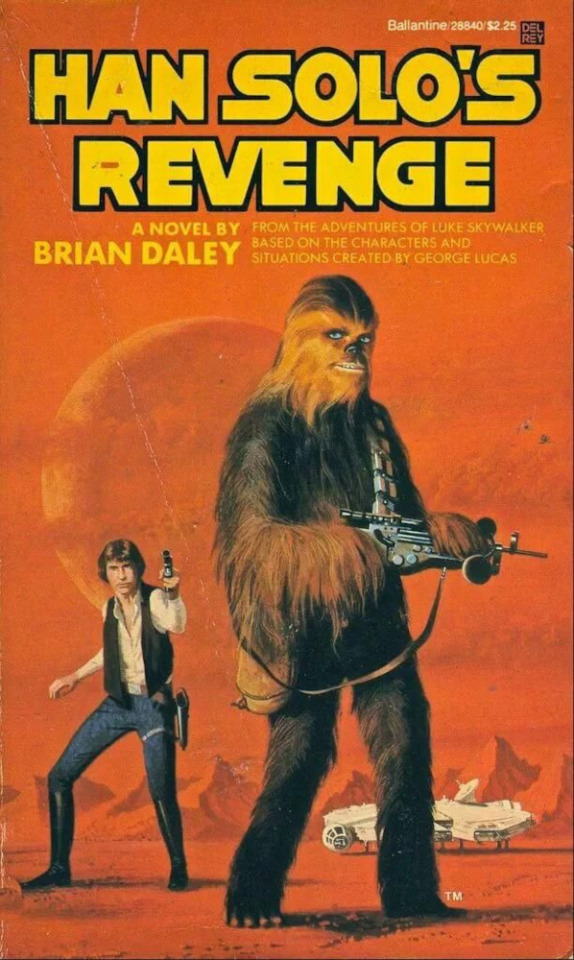

April 1979, October 1979, and August 1980. These novels by Brian Daley were not the first STAR WARS tie-ins, but they were the best of the early phase, and a strong influence on later SW media. The creative success of these exciting, frequently very funny books, which chronicle three adventures of Han Solo and Chewbacca prior to the first movie, had a lot to do with Daley himself. According to Daley's friends and his partner, novelist Lucia St. Clair Robson, Daley was Han Solo, or close to it: a brash military veteran with no love of authority, a fondness for sports cars and motorcycles, and a notoriously sarcastic sense of humor that concealed a heart of gold. Ironically, Daley, who genuinely loved STAR WARS, would have preferred to explore the history of the Jedi, but Lucas declared that off-limits, and imposed many restrictions on what Daley could and couldn't use from the films. For that reason, the novels take place on the fringes of the Empire: The first two books are set in the Corporate Sector, a region administered semi-autonomously by corporate interests with their own ruthless Security Police (an idea that clearly inspired some of the plot of ANDOR), while the third is set in the Tion Hegemony, a remote principality.
HAN SOLO AT STARS' END has Han and Chewie roped into aiding a group of people whose relatives have been "disappeared" by the Corporate Sector Authority, which is quietly rounding up dissidents and sending them to a secret facility called Stars' End. After Chewbacca is captured by the Security Police, Han concocts an elaborate, harebrained scheme to rescue his friend and the other "lost ones" from the galaxy's most closely guarded high-tech prison. Naturally, things don't go quite as planned, leading to a spectacularly ludicrous finale. (Spoiler: Han accidentally launches the prison complex into space.) This novel was subsequent adapted for the STAR WARS newspaper strip by Archie Goodwin and Alfredo Alcala, although the adaptation unfortunately isn't a patch on the original.
HAN SOLO'S REVENGE finds Han and Chewbacca, desperate for cash, taking a job that turns out to involve transporting slaves. This is a line our heroes will not cross, so after dealing harshly with the slavers, Han agrees to help a Corporate Sector Authority auditor named Fiolla of Lorrd track down the ringleaders of the operation, one of whom is her once-trusted assistant, Magg. Meanwhile, Chewbacca is forced to contend with a stubborn skip-tracer called Spray, who is determined to repossess the Millennium Falcon over Han and Chewie's unpaid bills!
HAN SOLO AND THE LOST LEGACY has Han and Chewbacca agreeing to help Han's old buddy Badure, Badure's friend Hasti, and an academic named Skynx locate a legendary lost starship, the Queen of Ranroon, the fabled treasure ship of an ancient tyrant called Xim the Despot. (The skull on the cover is Xim's emblem.) Although this sounds like it was influenced by RAIDERS OF THE LOST ARK, the book was actually published almost a year before the premiere of RAIDERS.
Although the novels make clear that Han is not overly fond of droids, the books give Han and Chewbacca a pair of droid companions: a laconic old labor droid called Bollux, and a small, extremely sophisticated, disconcertingly enthusiastic computer probe called Blue Max, who "lives" within a compartment in Bollux's chest. Here's how Alfredo Alcala depicted them in the comic strip:

Daley also includes some delightful aliens, including the skip-tracer Spray, who's a Tynnan — basically a sentient beaver with the dexterity of a raccoon — and the Ruurian academic Skynx, a sentient caterpillar who's determined to complete as much of his research as he can before entering the next phase of his life cycle and becoming a chroma-wing who'll have little memory of his former identity.
A useful companion for the first two books is Michael Allen Horne's HAN SOLO AND THE CORPORATE SECTOR SOURCEBOOK for the West End STAR WARS RPG, published in 1993:

Aside from the inevitable game statistics and some quite decent illustrations of the novels' characters, the sourcebook fleshes out Daley's conception of the Corporate Sector Authority, explaining how the Corporate Sector functions and its relationship to the Empire. This is narrated in part by Han Solo himself, which is presented as excerpts of later interviews with an Alliance historian named Voren Na'al (a common conceit in the WEG game books that works especially well here). The sourcebook is best read after the novels, since it explains their plots in detail, but it's a worthwhile supplement. Unfortunately, a planned followup describing the Tion Hegemony was never published before West End Games lost the SW license.
Brian Daley's other major contribution to STAR WARS lore was scripting the NPR radio adaptations of the first three movies. STAR WARS originally aired in the spring of 1981, THE EMPIRE STRIKES BACK two years later. Daley also wrote the later adaptation of RETURN OF THE JEDI, but he died of cancer in early 1996, at the age of 49, so the final drafts were completed by John Whitman.
#books#star wars expanded universe#han solo adventures#brian daley#wayne douglas barlowe#dean ellis#william schmidt#han solo#chewbacca#corporate sector authority#archie goodwin#alfredo alcala#star wars andor#star wars
20 notes
·
View notes
Text
Okay, I really need to talk about some of the absolute clownery that was Hyde and Hilda's first meeting with each other.
Again, keeping the lore and whatnot brief here , Hyde was guided to Hilda's manor and base of operations by Kuon, Linne's brother and fellow immortal, for what I will summarize as Final Boss Reasons™. Hyde, being given vague implications that Linne might be in harm's way at said manor, immediately runs over and quickly realizes Kuon was trying to lead him into a trap. He tries to leave, only to be stopped by Hilda.
Hyde then proceeds to fumble every single ball he's tossed in his attempt to escape.
He immediately stammers out that he totally wasn't sneaking around the manor. That he totally wasn't talking about Amnesia while thinking aloud. That he absolutely isn't spying on them or anything.
Obviously Hilda doesn't not buy this, and immediately outs Hyde as an In-Birth by observing his vessel, the special spiritual thingy that shows your EXS powers which is located around the chest. Hyde tries to do the same... only to realize he's staring directly into Hilda's massive cleavage and reacts as any innocent high school boy would. Hilda immediately jumps on this and proceeds to give Hyde massive cringe damage by prancing (canonically worded this way) around him, lifting her skirt, twirling about like a Disney princess, and otherwise destroying Hyde's sanity even further before revealing herself as the leader of Amnesia.
She then invites Hyde inside her base to chat over tea and snacks.
Hyde, having functioning brain cells, understandably refuses. At least until Hilda threatens to make a scene. Like, she legit threatened to scream, cry, call security, and make a fuss on camera to blackmail Hyde. And so Hyde reluctantly follows Hilda to her penthouse suite against his will.
There's a few more shenanigans that happen after Hyde's inside the building, but I'll let you all just read through Chronicle Mode to learn the details. And those details are even further clownery.
10 notes
·
View notes
Text
By Palestine Chronicle Staff
In a statement to the UN Security Council Briefing on the Middle East on Tuesday, Ambassador Fu Cong condemned Israel’s targeting of “civilians and the civilian infrastructure”.
China’s envoy to the UN has urged the United States to “take sincere and responsible actions to push Israel to stop its military operations in Gaza as soon as possible and to stop slaughtering civilians.”
In a statement to the UN Security Council Briefing on the Middle East on Tuesday, Ambassador Fu Cong condemned Israel’s targeting of “civilians and the civilian infrastructure” saying “This is a red line under the international humanitarian law.”
4 notes
·
View notes
Text
Despite the popularity of "Stranger Things" it is little known that it is actually based on the Montauk Project, a conspiracy that supposedly involved the kidnapping of orphans who were subjected to physical and psychological torture to research the possibility of time travel, teleportation, & mind control.
In 2015, Filmmaker Christopher P. Garetano released his documentary The Montauk Chronicles, based on 10 years’ worth of research, and more recently continued his investigation for the History Channel series, The Dark Files. And he’s not the only one hooked by the conspiracy theory. The legends of Montauk – experiments on children, alien abductions, time travel, psychic powers, journeys to the far side of the galaxy, mind-bending drug tests, and monsters conjured out of thin air – were also the original inspiration for Stranger Things.
The stories are commonly thought to have started with the book The Montauk Project: Experiments in Time by Preston B. Nichols and Peter Moon, a novel about the supposed events. Nichols claims to be an electrical engineer who worked on the project in real-life.
“As I say in the book,” he tells Garetano in Dark Files, “you can believe it as fact, or you can believe it as science fiction.” Nichols’ account, along with those from alleged time-traveller Al Bielek, and a handful of survivors make up the popular narrative of the Montauk conspiracy theories.
Children are said to have been abducted and subjected to horrific torture – with many of them dying – to create Manchurian Candidate-style super spies. According to Nichols, they were “shattering their minds, programming them, then putting them back together.”
The survivors of these experiments are known as the “Montauk Boys”, and the most famous of them is Stewart Swerdlow, a self-professed “Hyperspace Intuitive” who’s part alien abduction survivor, part new age healer (he’ll “de-programme” you from the government’s mind control for a cool $300). According to Swerdlow, alien beings snatched him while his parents were brainwashed; he was then experimented on at Camp Hero, and sent back in time on secret missions.
Another survivor, identified under the alias “James Bruce” in Garetano’s documentaries, recalls mind-bending drug tests in so-called “Acid Houses” at Camp Hero. The drugs, he says, could create psychic link with other subjects.
The US government does have a proven fascination in paranormal phenomenon and parapsychology. In January of this year, the CIA dumped over 13 million files online, revealing details of the agency’s “Stargate” programme, which ran from the 1970s to 1990s and involved tests into psychic abilities, research into UFOs, and a particular interest in “remote viewing” – seeing far-off objects or places with the mind. One file even attempts to document an attempt at astral projection to the surface of Mars.
Between the 1930s and 1970s, the US authorities were responsible for some hideous experiments in the name of science and national security: the Tuskegee syphilis study, which duped African American men into being infected with the disease and left them untreated; MK Ultra, a secret CIA operation into “mind control” techniques for interrogation and torture, which administered drugs to unwitting civilians; and the experiments in Philadelphia’s Holmesburg Prison, where tests were carried out on prisoners’ skin using biochemical substances, including dioxin, a highly carcinogenic ingredient in Agent Orange.
“My thinking is, if happened in one place – or even two or three places – I wouldn’t put it past it happening at Camp Hero,” says Garetano. And with its already-dodgy track record, the US government testing drugs does sound credible next to aliens, monsters, and time travelling soldiers. “Survivors always talk about an injection being given to them,” says Garetano. “You can imagine that a highly experimental hallucinogen could cause them to think they’re seeing these things.”
5 notes
·
View notes
Text
Civil War Isn’t the Movie You Think It Is

Americans sure do love to see their institutions destroyed onscreen.
I remember back when it was sorta-kinda news that audiences applauded and cheered as aliens blew up the White House in Roland Emmerich’s Independence Day (1996).
Since then, it’s been standard operating practice for blockbusters, particularly the disaster-y ones, to incinerate or otherwise defile a monument or an iconic government building.
(We took a brief recess after 9/11 — “too soon,” etc. — but went right back to it once the cultural all-clear sounded.)
Maybe because our institutions were deemed so secure and unchanging for so long, the idea that they might be ravaged by aliens, meteors, zombies, or Dylan McDermott became a naughty fantasy we were eager to see played out onscreen, over and over and over again.
A variation on this kind of chaos has become all too real over the past few years, with more than 40 percent of the country in a 2022 poll saying they think a civil war is likely within the next decade.
I’m not entirely convinced that the constant barrage of apocalyptic destruction on our screens is unrelated.
We’ve been spectators to the fantasy for so long that we’ve come to imagine we’re participants in it.
Here’s another truth about repeatedly indulging in our fantasies:
We become desensitized to them.

What makes Alex Garland’s Civil War so diabolically clever is the way that it both revels in and abhors our fascination with the idea of America as a battlefield.
No real monuments get done blowed up real good in this one.
The spectacle this time is coyer but somehow all-consuming.
What’s being incinerated in Civil War is the American idea itself.
The film is set in what appears to be the present, but in this version of the present a combination of strongman tactics and secessionist movements have fractured the United States into multiple armed, politically unspecified factions.
The president (Nick Offerman) has refused to give up power and is now serving his third term; he’s dissolved the FBI, bombed American cities, and made a point of killing journalists on sight, or so we’re told.
California and Texas have joined forces and become something called the Western Front.
There’s also the so-called Florida Alliance.
Smoke rises from the cities; the highways are filled with walls of wrecked cars; suicide bombers dive into crowds lined up for water rations; death squads, snipers, and mass graves dot the countryside.
How we got here, or what these people are fighting over, is mostly meaningless to Kirsten Dunst’s Lee and Wagner Moura’s Joel, two war journalists making the treacherous drive from New York City to Washington, D.C., for an exclusive, probably dangerous interview with the beleaguered president.
Tagging along for the ride in their van are Jessie, played by Cailee Spaeny, a young, inexperienced photographer who aspires to a career like Lee’s, and Sammy (Stephen McKinley Henderson), an aging reporter who wants to go to the front lines in Charlottesville.
Lee is vexed by both their presences.
Jessie’s too young, and Sammy’s too old.
The blood-soaked highways of the divided states of America are no place for either of them.
The journalists covering this war gather in hotel bars, get drunk, and loudly yuk it up with the jacked-up bonhomie we might recognize from movies set in foreign lands like The Killing Fields, Under Fire, and Salvador.

They’re mostly numb to the horrors they’re chronicling.
After the young Jessie is scarred by an early run-in with a man who threatens to shoot two unarmed, tortured, barely alive captives, Lee tells her that it’s not their job to ask questions or get involved:
“We take pictures so others can ask these questions.”
One of the reasons Lee is such a legend in her field is because she has grown a protective shell around herself.
She wants to get the picture.
That’s it.
She’s protective of Jessie but only to the extent that the girl will slow them down or upend their plans.
“Would you photograph that moment, if I got shot?” Jessie asks.
“What do you think?”
Lee responds, as if the answer is obviously yes.
But we also understand that Lee bears the psychological scars of what she’s seen.
At night, alone in her bath at a hotel, she covers her eyes and revisits the horrors she’s photographed all over the world.
“I thought I was sending a message home: Don’t do this,” she says of her earlier work. “But here we are.”
Garland can be clunky and obvious with his dialogue, but Dunst can also make just about any line sound true.
Her face tells one story, her words tell another; together, they bring this conflicted woman to life.
The film embodies Lee’s traumatized numbness to a degree.
Garland knows how to build suspense, and he depicts astonishing violence with the requisite horror, but he also moves his film along in playfully provocative ways.
youtube
After one ghastly sequence in which guerrillas shoot a weeping soldier, the director cuts to a montage set to De La Soul’s “Say No Go,” a song about a horrific subject that adds a peppy beat to the grisly images onscreen.
youtube
(I was reminded of the way Stanley Kubrick’s Full Metal Jacket cut to the Trashmen’s “Surfin’ Bird” right after a similar firefight.)
youtube
Even the film’s episodic quality — it’s really just a ghastly travelogue through the war-torn Eastern Seaboard, with our protagonists confronted at each stop with some upsetting new incident — feels like a provocation.
Part of shutting yourself off to such horrors involves being able to move past them, and Civil War, like its characters, glides past each monstrous vignette with unbothered brio.
This can make the film feel weirdly weightless at times.
Its characters are observers and nomads.
If anything, they feel less invested in what they’re witnessing as the movie goes on.
Civil War’s lack of a political point of view, as well as its refusal to really identify the positions of its warring parties, has come in for some understandable criticism.
But does any sane person really want a version of this film that attempts to spell out these people’s politics or, even worse, takes sides in its fictional conflict?
(That sounds like it would be the worst movie ever made.)
Garland does include flashes of real news footage from a variety of recent American disturbances, but he’s clearly done more research into media depictions of other countries’ war zones.
This is maybe his best idea, and why the film’s lack of political context feels more pointed than spineless:
The conceit here is to depict Americans acting the way we’ve seen people act in other international conflicts, be it Vietnam or Lebanon or the former Yugoslavia or Iraq or Gaza or … well, the list goes on.
In that sense, Civil War winds up becoming a movie about itself.
Beyond the plausibility of war in the United States or the tragedy of such an eventuality, it’s about the way we refuse to let images from wars like this get to us.
It’s more a call for reflection, an attempt to put us in the shoes of others, than a warning — not an It Can Happen Here movie, but a Here’s What It’s Like movie.
It doesn’t want to make us feel so much as it wants us to ask why we don’t feel anything.
2 notes
·
View notes
Text
Israel Purchases AI Systems to Counter ‘Clear Loss’ on Digital Battlefield - Haaretz
In a report published on Tuesday, the Israeli newspaper Haaretz cited “numerous sources with knowledge of the matter” as saying that Israel has responded to “its ‘clear loss’ to Hamas on the digital battlefield by making its first-ever purchase of a technological system capable of conducting mass online influence campaigns”.
According to Haaretz, “The technology was purchased as part of a wider attempt by Israeli bodies, both civilian and military, to address what sources termed ‘Israel’s public diplomacy failure’,” following the Hamas military operation on October 7 and the subsequent genocidal war on Gaza.
Countering Anti-Israel Content
The sources reported that the system is intended to address what they call an online “hate machine”, which “undercut the rationale behind the war and the IDF spokesperson’s credibility”.
“The first hour of the war revealed how hopelessly unprepared Israel’s defense establishment was for handling social media platforms like Instagram and TikTok, and even messaging apps like Telegram,” the report stated.
According to Haaretz, since the start of the war, “Hamas has led a massively successful public communications campaign, which sources describe as a ‘PsyOp – 0r a ‘psychological’ influence operation.”
The system aims to counter anti-Israel online content, including “Anti-Israel posts expressing political support for the Palestinians and opposing Israel’s conduct.”
“Israeli civilian volunteers have tried to make Israel’s case online, as well as reporting posts that break platform rules,” the report added.
The “civilian volunteers”, however, seem to be part of a larger scheme.
In fact, according to the report, “a few weeks into the war, Israel set up a ‘hasbara forum’ comprising government agencies, offices and ministries, as well as military, defense and intelligence bodies – including the IDF, the Shin Bet security service and the National Security Council – alongside tech firms, civilians volunteer initiatives and even Jewish organizations, that meets weekly.”
Mapping Online Audiences
According to Haaretz, Israel purchased existing technology, including “A number of civilian tools and programs developed for business and political campaigns”.
Specifically, these tools included: “A system for mapping online audiences; a system capable of automatically creating websites, among other things, as well as content tailored to specific audiences; a system for monitoring social media and messaging platforms, and others.”
According to Haaretz, “the first campaign created by the system is already running online.”
Haaretz said that the Prime Minister’s Office denied the report stating that “Israel conducts its substantial international hasbara efforts openly.”
Losing All Credibility
The genocidal campaign on Gaza, which started on October 7, has sparked outrage worldwide.
“Not only is Israeli Prime Minister Benjamin Netanyahu losing credibility among Israelis, according to various public opinion polls. But the entire Israeli political establishment seems to be losing the trust of ordinary Israelis as well,” Palestine Chronicle editors Ramzy Baroud and Romana Rubeo wrote in a recent article.
“Indeed, every day, Israel loses credibility to the point that the initial Israeli lies of what had taken place on October 7, eventually proved disastrous to Israel’s overall image and credibility on the international stage,” they added.
#signal boost#seek the truth#spread awareness#now we have to be twice as loud#israel is committing genocide#the US is complicit in genocide#israel is an apartheid state#apartheid#ethnic cleansing#collective punishment#collateral damage#illegal occupation#no amount of AI can change what the truth is#israeli lies#israeli war crimes#idf are terrorists#netanyahu is a war criminal#save palestine#free palestine 🇵🇸#stand with palestine#stand up for humanity#gaza under attack#stolen lives#stolen land#stolen futures#stolen culture#genocide#this was never about hamas#the world is watching#seek truth
5 notes
·
View notes
Text
styxnbones oc masterpost
reference list for all the silly little brain blorbos in order of their creation


Cassandra "Cass" Briar: she/they, 9th gen Carrier Malkavian, Anarch/Sabbat-sympathetic Autarkis, information broker, free roaming at the moment but formerly based in Los Angeles and New Orleans
Tag | Main Info Post | Playlist
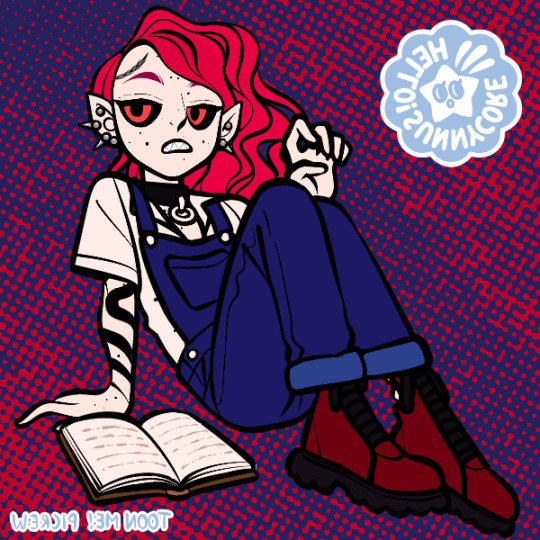

Kellen Merot: they/them, 12th gen Tzimisce, Autarkis, museum conservator based in Montreal
Tag | RP blog | Playlist


Minerva: they/he, 8th gen Malkavian Antitribu, Sabbat, Black Hand, ductus of The Pantheon Pack
Tag | RP Blog | Playlist
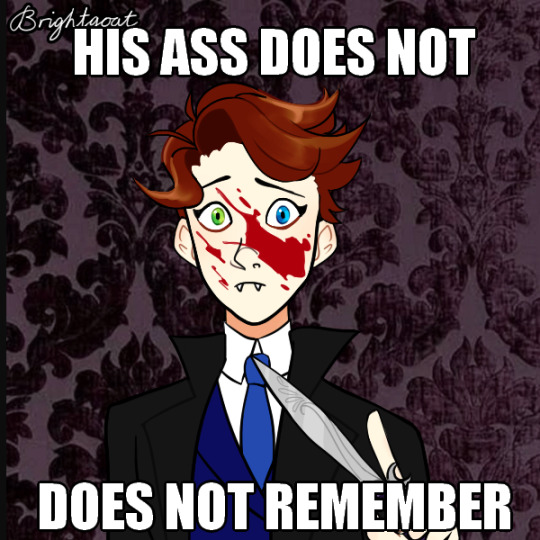

Corin Antoine "Liber" Deserres: he/him, 11th gen Ventrue Antitribu, Sabbat, former Seneschal of Ottawa, now Minerva's boyfriend in Montreal with The Pantheon pack. (Was also based on both the protagonist of Parliament of Knives, and Bloodhunt's Ventrue Enforcer)
Tag | RP Blog | Playlist


Harper Matheson: they/he/she, 12th gen Nagaraja Hecata, Camarilla, Scourge of Baltimore (or New Orleans in an au)
Tag | RP Blog | Playlist
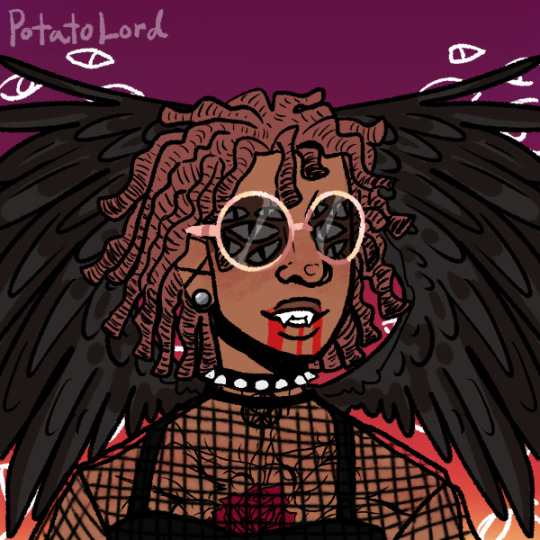

Peona/Thorn: she/they, 10th gen Tzimisce, Sabbat, member of The Pantheon pack, priest for The Path of Cathari
Tag | Playlist


Pluto (Silas McAllister): he/him, 10th gen Lasombra, Sabbat, member of The Pantheon Pack
Tag | Playlist
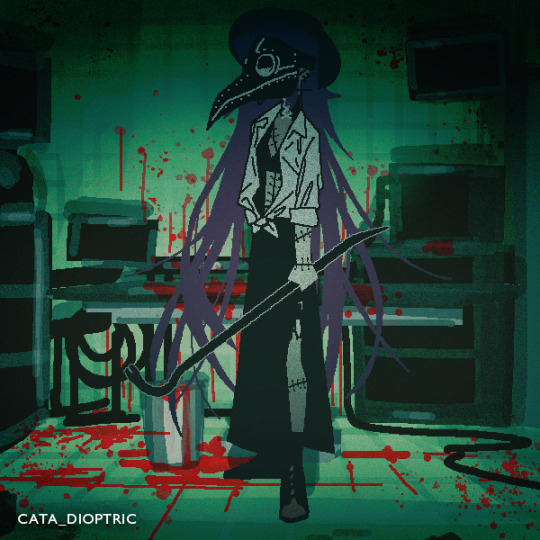
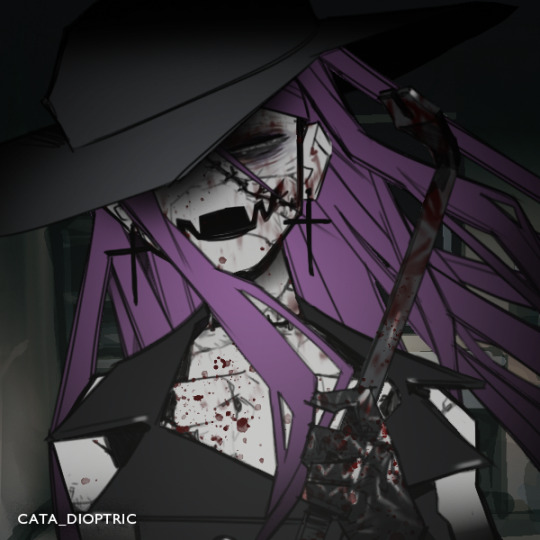
Adaline, The Obsidian Mask & Francesca Faustina Fioranti (she/her for both), 8th gen Harbinger/Hecata and the even older wraith of a former Cappadocian/Harbinger, nominally Sabbat (mostly in pursuit of their own goals/as a hobby), recently awoken from a 7 year torpor under the Atlantic
Tag | RP Blog | Playlist
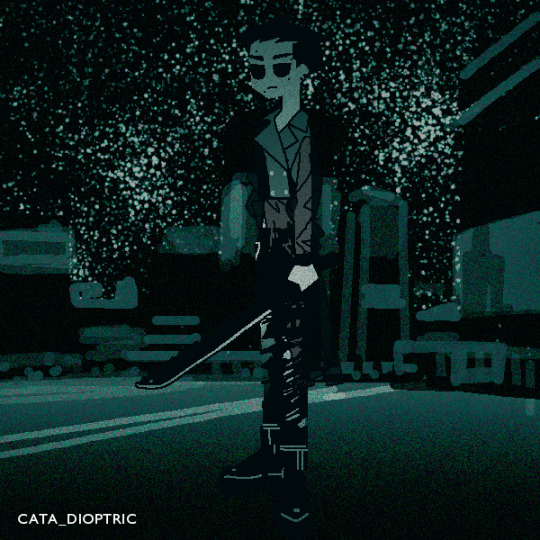
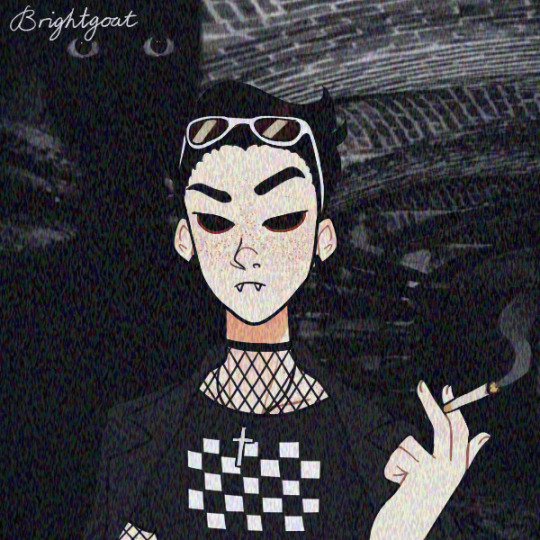
Sev, he/they, 11th gen (secretly Caitiff ) Lasombra Primogen of Kingston, recently ex-sabbat having defected to the Camarilla after their pack was purged by hunters. My character for the Kingston By Night: Aftermath larp.
Tag | RP Blog | Playlist


Damien Kimber, also known as Naviel, Architect of Wishes (and former Angel of the Beaten Path), they/it/he, Ravener Malefactor, bomb specialist and wanted criminal in Las Vegas
Tag | Playlist | RP Blog


Caleb Quincey, he/him, 9th gen Gangrel organovore, ex-sabbat turned anarch post-100 Year Dirt Nap (also, ex-boyfriend of Harper's sire). Loosely based on the protagonist of cult classic build engine fps BLOOD (1997). Also, my character for the Canada At Midnight Good Intentions Chronicle larp.
Tag | Playlist

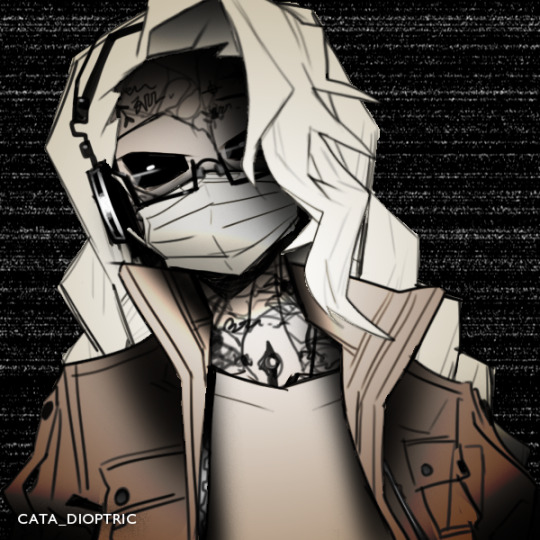
Palimpsest, mirror pronouns, 10th gen Kiasyd, broadly Camarilla affiliated, former changeling and Sickly Victorian Orphan
Tag | Playlist


YJ, also known by stage name NOSICAÄ, they/them, 13th gen Caitiff, Anarch, Uncle Fangs to a gaggle of duskborn and home base to a hive of wasps
Tag | Playlist | RP Blog


Carillon, he/him, 9th gen Tremere of House Goratrix, Camarilla (functionally), former Sabbat Inquisitor turned Infernalist.
Tag | Playlist | RP Blog


Agent Avery "Mayfly" Felix, he/they, NWO Operative, based out of the New York Construct front "Axiom Security," brightest upcoming agent in his division, and personal pet project of the Director. (NPC I wrote/played for Darkness Emergent in Chicago)
Tag | Playlist | RP Blog
#cass oc#kellen oc#danny oc#minerva oc#corin oc#harper oc#peona oc#the pantheon pack#pluto oc#ada&fran oc#sev oc#kimber oc#caleb oc#pal oc#yj oc#carillon oc#felix oc#also ty chiss for the idea to do a post like this
23 notes
·
View notes
Text
FLASH REPORT: Independent Texan Production Company and Animation 'Rooster Teeth' permanently closes down for bankruptcy after 2 decades, RWBY's future in Limbo as 'DillonGoo Studios' steps in

FORT WORTH, TEXAS -- Warner Bros.-Discovery (WBD) sadly announces to close down the established independent animation studio 'Rooster Teeth' after two (2) decades of digital operation. This moves might be a bitter pill for many to swallow that marks the end of an era for the studio behind a beloved web series 'RWBY'.
Entertainment news outlet ‘Deadline’ revealed that the Texan animation studio shuts its doors, but the popular audio-only podcast known as the ‘Rooster Teeth Podcast’ (RTP) won't be impacted there too soon.
The unprecedented closure for online bankruptcy of 'Rooster Teeth' leaves fans of RWBY in a state of much uncertainty, as the fate of the web streaming series hangs in the balance, following after the old video-sharing platform YouTube in several volumes. However, a glimmer of hope emerges as the torch passed on to a different independent studio, DillonGoo Studios, based in Austin, Texas, United States of America (U.S.A.).
'DillonGoo Studios', led by its Chief Executive Officer, independent self-animator and founder named 'Dillon W. Gu', has rapidly emerged as a prominent figure in the animation community. With strong connections to the RWBY fandom, the studio has garnered significant attention. The potential partnership production between 'DillonGoo Studios' and 'RWBY' opens exciting prospects for the series' future to a new heights. With 'Mr. Gu' stepping into the role as a new show creator, apart from the late original series creator (Monty Oum), fans eagerly anticipate the direction that Volume 10, potentially its final season as 'volumes' may take under a new leadership.
People are speculating about 'Rooster Teeth' (RT) considers to be shutting down, filing for bankruptcy, and selling RWBY to acquire a new IP (intellectual property) to DillonGoo Studios. Some have mentioned that RT encountered financial difficulties and a decrease in the appeal of their animations, possibly influenced by controversial anti-LGBT sentiments, extremist criticism, fouling behavior on social media, and disruptions caused by boycotts against CRWBY members, voice actors and fictional personalities, resulting to delay and secure a new volume. But now, with 'DillonGoo Studios' stepping in, there's hope for the future of the web-streaming series.
If DillonGoo Studios takes the helm for Volume 10 of RWBY and securing a partnership with streaming networks like Crunchyroll or somewhat others (which is our internet media affiliate for 'OneNETtv Channel'), it could signify a revitalization for the beloved franchise. The legal greenlighting of Volume 10 under the banner of DillonGoo Studios opens up avenues for a fresh approach to storytelling, while retaining the essence and spirit of the series that has captivated audiences worldwide.
As RWBY-nian fans eagerly await the future of the show, the partnership between DillonGoo Studios and a streaming platform holds the promise of a bright new chapter for the iconic series. With 'Dillon Gu' at the helm, RWBY may embark on a journey filled with innovation, creativity, and a renewed sense of purpose, ensuring its enduring legacy in the annals of animation history.
CONTRIBUTED LOGO and ART PHOTO COURTESY: AyRigatory via Reddit PHOTO & Google Images
BACKGROUND PROVIDED BY: Tegna
SOURCE:
*https://deadline.com/2024/03/rooster-teeth-shut-down-warner-bros-discovery-roost-podcast-continue-1235847264/ [Referenced News Article via Deadline Hollywood]
*https://www.austinchronicle.com/daily/screens/2024-03-06/rooster-teeth-shutting-down/ [Referenced News Article via The Austin Chronicle]
*https://epicstream.com/article/rwby-volume-10-release-date-where-to-watch-trailer-all-details [Referenced News Article via Epic Stream]
*https://roosterteeth.com/g/post/af39b172-be74-4398-94f8-908c3f4c5d6e [Referenced PR Post via Rooster Teeth News Bureau]
*https://twitter.com/DillonGoo/status/1765562185990762798 [Referenced X Network Status Post via DillonGoo]
*https://www.instagram.com/p/Cy6O1yWopCP/ [Referenced IG News Article via The RWBY Style News Bureau]
*https://www.youtube.com/watch?v=UcpQK9Qzf3g [Referenced YT VIDEO via Vexed Viewer]
*https://rwby.fandom.com/wiki/Dillon_Gu
*https://www.linkedin.com/in/dillon-gu-52b1b489
*https://www.dillongoostudios.com/about
and
*https://old.reddit.com/r/roosterteeth/comments/123ar0f/i_made_legit_adjustments_to_rooster_teeths_new/ [Referenced Fan-Made Logo via Reddit User - AyRigatony]
-- OneNETnews Team
#flash report#entertainment news#fort worth#texas#RWBY#rooster teeth#shutting down#bankrupt#animation#dillon goo studios#fyp#awareness#OneNETnews
4 notes
·
View notes